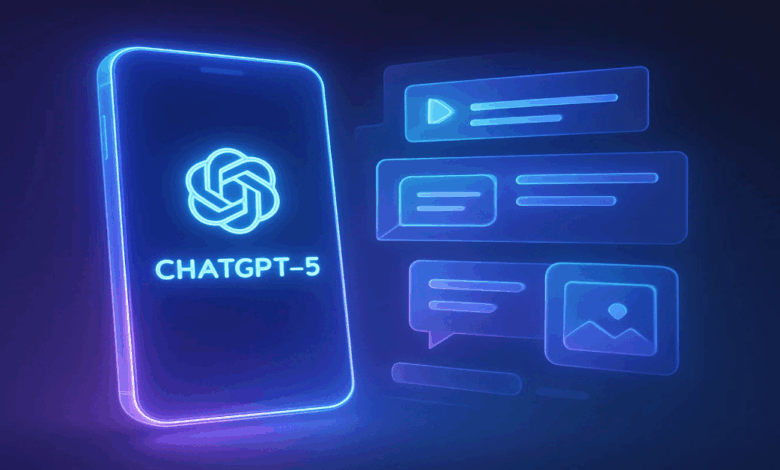
GPT-5 Just Killed the No-Code Market
Chatbot tools like ChatGPT-5 are no longer just conversation bots. With the official release of OpenAI’s most powerful artificial intelligence model yet, GPT-5, the barrier between “idea” and “app” is gone. You can now launch full-featured applications in under two minutes—without knowing how to code, design, or deploy anything.
That’s exactly what I did. One prompt. 2 minutes. Zero lines of code. And I had a working MVP with front-end, logic, and user flows live in the browser.
Here’s how I did it, how you can do the same, and why most no-code platforms should be very worried.
What GPT-5 Actually Did
When OpenAI introduced GPT-5, the most overlooked feature wasn’t intelligence. It was orchestration. GPT-5 isn’t just better at responding—it’s better at doing.
Here’s what made this possible:
- Built-in UI generator (HTML/CSS/JS)
- Integrated database logic and data mocking
- Seamless in-browser deployment
- Multi-step reasoning with memory
- Integration with voice + image input
All in one prompt.
Here’s the Exact Prompt I Used
I asked GPT-5:
“Build a web-based app that lets users create and manage digital mood boards. It should include:
- Image upload + drag-and-drop canvas
- Tagging system for categorization
- Save to local browser or export as PDF
Make the UI minimalist. Mobile responsive. All in one HTML file. Explain the parts.”
In under 90 seconds, it generated:
- HTML file with embedded JS/CSS
- Instructions to deploy it
- Explanation of how each section worked
- A downloadable link with the ZIP package
Table: GPT-5 vs No-Code Platforms
| Feature | GPT-5 | Webflow / Bubble / Glide |
| App generation time | 2 minutes | 45–120 minutes |
| Required UI interaction | One prompt | Drag-and-drop GUI |
| Code customization | Full access (editable HTML) | Limited |
| Export control | Full (host anywhere) | Subscription-bound |
| Cost | $20/month (ChatGPT Plus) | $29–$129/month per app |
| AI guidance | Yes | No |
GPT-5 doesn’t just replace the code layer—it replaces the build process entirely.
Why I Always Test These Prompts Inside Chatronix
Let me be blunt: GPT-5 is incredible, but on its own, it’s not always predictable. Sometimes it misses UX best practices or forgets error handling.
This is why I use Chatronix.
Chatronix isn’t just another wrapper. It’s my personal AI command center. I ran the same app-generation prompt through ChatGPT-5, Claude 3 Opus, and Gemini 1.5 Flash—all inside one screen.
Results:
- ChatGPT-5 built the best UI.
- Claude caught edge cases and added accessibility hints.
- Gemini improved export logic and added test coverage.
Chatronix let me merge the best output from all three. In minutes.
If you’re serious about building fast with AI, you need one interface that compares everything side by side. That’s why I run all app-building prompts directly through Chatronix.
You get:
- 10 free AI interactions
- Real-time turbo mode for heavy prompts
- 6 models in one workspace (including Claude, Gemini, Perplexity, Grok)
This isn’t a gimmick. It’s the fastest way to test, refine, and deploy app logic with zero guesswork.
The ChatGPT-5 Prompt Stack That Builds MVPs
Here’s my actual 3-prompt stack I use to build in under 10 minutes:
Prompt 1 – Idea to Structure
“I want to create a [type of app]. List the essential components, data flows, and UX expectations. Break it into features and modules.”
Prompt 2 – Generate UI + Logic
“Now generate the full app with HTML/CSS/JS. It should be [responsive / accessible / minimal]. Include validation and mock data if needed.”
Prompt 3 – Feedback loop
“Optimize the UX for mobile users. Add brief inline comments explaining each major block of code. Minimize load time and unnecessary requests.”
Run each one through multiple models in Chatronix, compare, tweak, and you’re done.
Real Use Cases That Are Already Working
In the last 2 weeks, I’ve used GPT-5 to build:
- A startup onboarding dashboard for a VC fund
- A resume review tool for LinkedIn freelancers
- A niche job board for AI consultants
- A recipe-scraping app for kitchen testing
- A mini CRM for course sales
None of these took more than 30 minutes end-to-end.
The Real Shift: From “Builder” to “Curator”
GPT-5 has shifted the skill stack. You don’t need to be a developer—you need to be a workflow thinker.
This is the new AI-powered loop:
- Think in terms of user flows
- Prompt GPT-5 to create components
- Compare models inside Chatronix
- Merge the best version
- Launch and iterate instantly
You’re no longer coding or dragging blocks. You’re designing logic.
Bonus Prompt: Turn Any ChatGPT Output Into a Hosted App
Here’s one you can save:
“Take this HTML/JS code and wrap it into a single downloadable file. Add browser-based hosting instructions and optional export to GitHub Pages or Netlify.”
I’ve used this exact format to launch apps in client meetings live. No one believes it’s built with zero code.
<blockquote class=”twitter-tweet”><p lang=”en” dir=”ltr”>ChatGPT – Cheat Sheet <a href=”https://t.co/jjojwstZ78″>pic.twitter.com/jjojwstZ78</a></p>— Book Therapy (@Book_therapy223) <a href=”https://twitter.com/Book_therapy223/status/1943568439022424162?ref_src=twsrc%5Etfw”>July 11, 2025</a></blockquote> <script async src=”https://platform.twitter.com/widgets.js” charset=”utf-8″></script>
Final Thought
GPT-5 didn’t just make app development faster—it made the entire “startup idea” cycle faster. The gap between your concept and customer is now 2 minutes wide.
But real leverage comes when you pair GPT-5 with a workspace that brings Claude, Gemini, Grok, and Perplexity into the same room.
That’s why I test everything through Chatronix. It’s not just faster—it gives me options GPT-5 alone can’t.
Want to try it? Run your next prompt through Chatronix and see how it compares.




